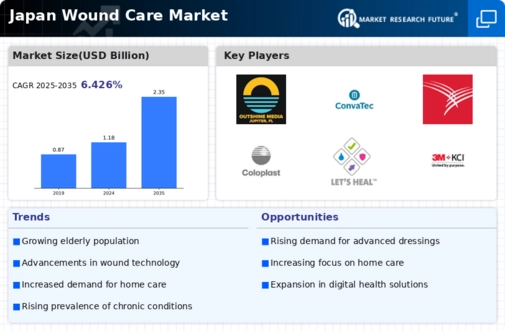Growing Awareness of Wound Care
There is a notable increase in awareness regarding wound care among healthcare professionals and patients in Japan. Educational initiatives and training programs have been implemented to improve knowledge about wound management, which is crucial for effective treatment. This heightened awareness is likely to lead to better wound care practices, thereby increasing the demand for specialized products in the wound care market. As healthcare providers become more informed about the latest advancements in wound care, they are more inclined to adopt innovative solutions, contributing to market growth. The emphasis on education and training is expected to continue, further enhancing the industry's landscape.
Increased Healthcare Expenditure
Japan's healthcare expenditure has been on an upward trajectory, which positively influences the wound care market. In 2023, healthcare spending reached approximately $500 billion, with a significant portion allocated to wound management. This increase in funding allows for the adoption of innovative wound care technologies and products, enhancing patient outcomes. The wound care market benefits from this trend as hospitals and clinics invest in advanced wound care solutions, including antimicrobial dressings and negative pressure wound therapy. As healthcare budgets expand, the market is expected to experience sustained growth, driven by the demand for high-quality wound care products.
Supportive Regulatory Environment
The regulatory framework in Japan is increasingly supportive of advancements in the wound care market. The Pharmaceuticals and Medical Devices Agency (PMDA) has streamlined the approval process for innovative wound care products, facilitating quicker access to the market. This supportive environment encourages manufacturers to invest in research and development, leading to the introduction of novel wound care solutions. The wound care market is likely to benefit from this trend, as regulatory support fosters innovation and enhances competition among market players. As new products gain approval, the market is expected to grow, driven by the influx of advanced wound care technologies.
Rising Incidence of Chronic Wounds
The increasing prevalence of chronic wounds in Japan is a notable driver for the wound care market. Factors such as diabetes and vascular diseases contribute to this rise, with estimates suggesting that approximately 7.5 million individuals in Japan suffer from chronic wounds. This growing patient population necessitates advanced wound care solutions, thereby propelling market growth. The wound care market is adapting to these needs by developing specialized products that cater to chronic wound management, including advanced dressings and bioengineered tissues. As the healthcare system in Japan continues to evolve, the demand for effective wound care solutions is likely to increase, further driving the market.
Technological Innovations in Wound Management
Technological advancements play a pivotal role in shaping the wound care market. Innovations such as telemedicine, smart dressings, and wound imaging technologies are transforming how wounds are assessed and treated. In Japan, the integration of these technologies into clinical practice is becoming more prevalent, leading to improved patient outcomes and streamlined care processes. The wound care market is witnessing a surge in demand for these advanced solutions, as they offer enhanced monitoring and management capabilities. As technology continues to evolve, it is anticipated that the market will further expand, driven by the need for efficient and effective wound care solutions.


















Leave a Comment